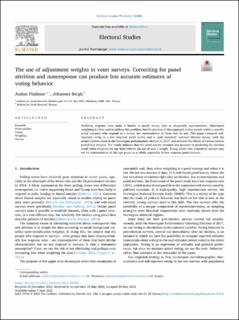| dc.contributor.author | Fladmoe, Audun | |
| dc.contributor.author | Bergh, Johannes | |
| dc.date.accessioned | 2023-03-08T08:35:05Z | |
| dc.date.available | 2023-03-08T08:35:05Z | |
| dc.date.created | 2022-06-08T13:44:56Z | |
| dc.date.issued | 2022 | |
| dc.identifier.issn | 0261-3794 | |
| dc.identifier.uri | https://hdl.handle.net/11250/3056924 | |
| dc.description.abstract | Declining response rates make it harder to justify survey data as adequately representative. Adjustment weighting is often used to address this problem, but the premise of that approach is that people within a specific social category who respond to a survey are representative of those that do not. This paper compares selfreported voting in a low response panel survey and a “gold standard” national election survey, with the actual election result in the Norwegian parliamentary election in 2017, and estimate the effects of various inverse probability weights. The results indicate that the panel sample becomes less accurate in predicting the election result when weighted for age than without the use of such a weight. Young adults who respond to surveys may not be representative of this age group as a whole, especially in low response panel surveys. | |
| dc.description.abstract | The use of adjustment weights in voter surveys. Correcting for panel attrition and nonresponse can produce less accurate estimates of voting behavior | |
| dc.language.iso | eng | |
| dc.relation.uri | https://doi.org/10.1016/j.electstud.2022.102486 | |
| dc.title | The use of adjustment weights in voter surveys. Correcting for panel attrition and nonresponse can produce less accurate estimates of voting behavior | |
| dc.title.alternative | The use of adjustment weights in voter surveys. Correcting for panel attrition and nonresponse can produce less accurate estimates of voting behavior | |
| dc.type | Peer reviewed | |
| dc.type | Journal article | |
| dc.description.version | publishedVersion | |
| dc.subject.nsi | VDP::Statsvitenskap og organisasjonsteori: 240 | |
| dc.subject.nsi | VDP::Political science and organisational theory: 240 | |
| dc.source.volume | 78 | |
| dc.source.journal | Electoral Studies: an international journal on voting and electoral systems and strategy | |
| dc.identifier.doi | 10.1016/j.electstud.2022.102486 | |
| dc.identifier.cristin | 2030232 | |
| dc.relation.project | Norges forskningsråd: 249687 | |
| cristin.ispublished | true | |
| cristin.fulltext | original | |
| cristin.qualitycode | 2 | |
